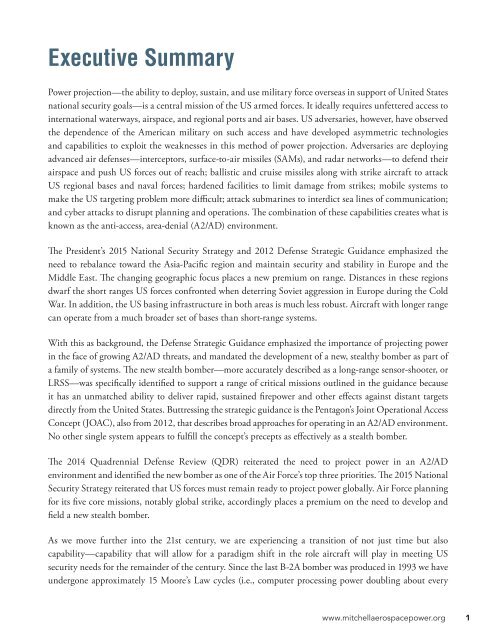Create successful ePaper yourself
Turn your PDF publications into a flip-book with our unique Google optimized e-Paper software.
Executive Summary<br />
Power projection—the ability to deploy, sustain, and use military force overseas in support of United States<br />
national security goals—is a central mission of the US armed forces. It ideally requires unfettered access to<br />
international waterways, airspace, and regional ports and air bases. US adversaries, however, have observed<br />
the dependence of the American military on such access and have developed asymmetric technologies<br />
and capabilities to exploit the weaknesses in this method of power projection. Adversaries are deploying<br />
advanced air defenses—interceptors, surface-to-air missiles (SAMs), and radar networks—to defend their<br />
airspace and push US forces out of reach; ballistic and cruise missiles along with strike aircraft to attack<br />
US regional bases and naval forces; hardened facilities to limit damage from strikes; mobile systems to<br />
make the US targeting problem more difficult; attack submarines to interdict sea lines of communication;<br />
and cyber attacks to disrupt planning and operations. The combination of these capabilities creates what is<br />
known as the anti-access, area-denial (A2/AD) environment.<br />
The President’s 2015 National Security Strategy and 2012 Defense Strategic Guidance emphasized the<br />
need to rebalance toward the Asia-Pacific region and maintain security and stability in Europe and the<br />
Middle East. The changing geographic focus places a new premium on range. Distances in these regions<br />
dwarf the short ranges US forces confronted when deterring Soviet aggression in Europe during the Cold<br />
War. In addition, the US basing infrastructure in both areas is much less robust. Aircraft with longer range<br />
can operate from a much broader set of bases than short-range systems.<br />
With this as background, the Defense Strategic Guidance emphasized the importance of projecting power<br />
in the face of growing A2/AD threats, and mandated the development of a new, stealthy bomber as part of<br />
a family of systems. The new stealth bomber—more accurately described as a long-range sensor-shooter, or<br />
LRSS—was specifically identified to support a range of critical missions outlined in the guidance because<br />
it has an unmatched ability to deliver rapid, sustained firepower and other effects against distant targets<br />
directly from the United States. Buttressing the strategic guidance is the Pentagon’s Joint Operational Access<br />
Concept (JOAC), also from 2012, that describes broad approaches for operating in an A2/AD environment.<br />
No other single system appears to fulfill the concept’s precepts as effectively as a stealth bomber.<br />
The 2014 Quadrennial Defense Review (QDR) reiterated the need to project power in an A2/AD<br />
environment and identified the new bomber as one of the Air Force’s top three priorities. The 2015 National<br />
Security Strategy reiterated that US forces must remain ready to project power globally. Air Force planning<br />
for its five core missions, notably global strike, accordingly places a premium on the need to develop and<br />
field a new stealth bomber.<br />
As we move further into the 21st century, we are experiencing a transition of not just time but also<br />
capability—capability that will allow for a paradigm shift in the role aircraft will play in meeting US<br />
security needs for the remainder of the century. Since the last B-2A bomber was produced in 1993 we have<br />
undergone approximately 15 Moore’s Law cycles (i.e., computer processing power doubling about every<br />
www.mitchellaerospacepower.org 1


